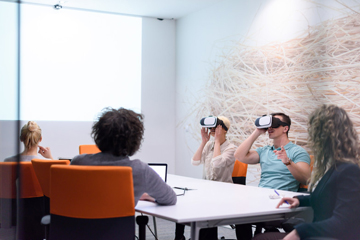
As technology is advancing, the process of holding conference calls and the equipment used for it are also changing. The latest trend in the conference call scenario is virtual reality. With equipment for virtual reality now on the consumer market, public tech companies and venture capitalists are exploring its possible application in everything from video games to medicines. The virtual reality market is expected to grow to $407 million and 25 million users by 2018.In 2016, $ 63 million Virtual Reality headsets were shipped compared to 1.5 million smartphones. Companies like Linden Lab say that soon it may be implemented in work meetings.
According to a global survey on attitude towards technology in the workplace by Dell Inc, Intel Corp and consultants Penn Schoen Berland, 57 percent of employees around the world prefer face-to-face conversation with colleagues. But more than half of them said that better communication technology can make such interactions outdated. Millennials were open to using virtual and augmented reality products at work with 77 percent saying they would try it.
Businesses use Skype for business communication, but it has its own shortcomings. VR or virtual reality may be the new solution for making uninterrupted and efficient conference calls. According to Eric Boyd, a professor of marketing at James Madison University, “It gets as close as we can right now to really replicate a face to face type of meeting”. He is guest editing an upcoming issue of the Journal of Business Research that focuses on virtual reality.
Video calls allow you to see facial expressions, and these calls do provide a certain level of closeness between the participants. However, you can understand their mental attitude only from the face, whereas being able to see how they are sitting, whether they are open and receptive, whether they are eager about what is being discussed, and so on would provide more detailed information. VR is advantageous in that it enhances interactivity and provides more information. With the provision of having individual “avatars,” it ensures a connection between personnel that a phone or video may not be able to provide.
Implementing VR in Meetings

The trend in remote work is one of the factors that will determine how widespread the adoption of VR meetings is going to be. Some companies are not encouraging remote work altogether in order to keep the company culture alive. IBM is one of the pioneers of remote work, but recently it stopped and asked the employees to either come back to the office or quit. However, according to Boyd, everyone is optimistic that in five years virtual meetings may be implemented in almost all companies and become popular in the business world; in 10 or 8 years we are very likely to see emerging technology that can completely support it.
Many companies are investing in virtual meetings though it is in experimental stage. Mike Harlick, head of the Bank of Ireland Worklab tweeted about virtual reality meeting that felt it to be “the future of collaboration”. He told The Wall Street Journal that his firm is experimenting with various virtual conferencing centres. He doesn’t believe that virtual meetings will replace video calls, but it does provide functions that other collaboration tools do not offer. He thinks that this will help him and his team to be more effective in the way they communicate.
Technological advancements are transforming the conventional manner of conducting a business meeting. However, recording and transcribing videos and audios, and conference transcription service will continue to play a crucial role in business settings.



